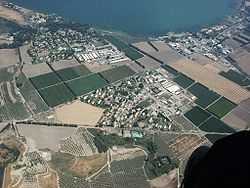Degania Bet
| Degania Bet דְּגַנְיָה ב' | |
|---|---|
| Hebrew transcription(s) | |
| • standard | Dganya Bet |
 in the center | |
 Degania Bet | |
| Coordinates: 32°42′0″N 35°34′33.6″E / 32.70000°N 35.576000°ECoordinates: 32°42′0″N 35°34′33.6″E / 32.70000°N 35.576000°E | |
| Council | Emek HaYarden |
| Region | Sea of Galilee |
| Affiliation | Kibbutz Movement |
| Founded | 1920 |
| Founded by | Immigrants from the Second Aliyah |
| Population (2008) | 514[1] |
| Website | www.degania-b.org.il (Hebrew) |
Degania Bet (Hebrew: דְּגַנְיָה ב') is a kvutza or kibbutz in northern Israel. Located to the south of the Sea of Galilee adjacent to Degania Alef, it falls under the jurisdiction of Emek HaYarden Regional Council. In 2008 it had a population of 514.[1]
The village was founded in 1920 by immigrants from the Second Aliyah,[2] led by Levi Brevda (Levi Ben Amitai).[3] It was the first planned kibbutz and was designed and built by the architect Korenberg.[4] One of its founders was Levi Eshkol. During the 1920 Palestine riots it was attacked and abandoned for several months.[2]
During the 1936-39 Arab revolt it served as a base for establishing tower and stockade settlements.[citation needed] During the Battles of the Kinarot Valley in the 1948 Arab-Israeli War the residents of Degania Alef and Bet succeeded in halting the advance of the Syrian army into the Jordan Valley.[2]
In addition to its 350 cow dairy herd, crop fields, almond orchards, banana, date and avocado plantations, Degania Bet industrialized in the 1960s with Degania Sprayers, now a green industry; in 1984 it opened the Degania Silicone factory. An additional source of income is its kibbutz cottage tourist accommodation, and it specializes in organized bicycle tours.
Notable residents include Michael Kolganov, a bronze medalist in rowing at the 2000 Summer Olympics.
References
- ↑ 1.0 1.1 "Locality File" (XLS). Israel Central Bureau of Statistics. 2008. Retrieved 2010-07-10.
- ↑ 2.0 2.1 2.2 Mapa's concise gazetteer of Israel. Yuval El'azari (ed.). Tel-Aviv: Mapa Publishing. 2005. p. 125. ISBN 965-7184-34-7. (Hebrew)
- ↑ http://kehilalinks.jewishgen.org/lyakhovichi/Biographyhome.htm
- ↑ Chyutin, Michael and Bracha (2007-04-24). Architecture and Utopia. Ashgate Pub Co. p. 90. ISBN 0-7546-4831-1.
External links
| Wikimedia Commons has media related to Degania Bet. |
- Kvutza website (Hebrew)
| |||||||||||